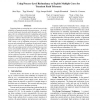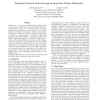87 search results - page 1 / 18 » Exploiting Instruction Redundancy for Transient Fault Tolera... |
DFT
2003
IEEE
13 years 10 months ago
2003
IEEE
This paper presents an approach for integrating fault-tolerance techniques into microprocessors by utilizing instruction redundancy as well as time redundancy. Smaller and smaller...
DSN
2007
IEEE
13 years 11 months ago
2007
IEEE
A new approach is proposed that exploits repetition inherent in programs to provide low-overhead transient fault protection in a processor. Programs repeatedly execute the same in...
DSN
2007
IEEE
13 years 11 months ago
2007
IEEE
Transient faults are emerging as a critical concern in the reliability of general-purpose microprocessors. As architectural trends point towards multi-threaded multi-core designs,...
ASPLOS
2006
ACM
13 years 11 months ago
2006
ACM
Redundant threading architectures duplicate all instructions to detect and possibly recover from transient faults. Several lighter weight Partial Redundant Threading (PRT) archite...
ISCAPDCS
2001
13 years 6 months ago
2001
In this paper, we propose a fault-tolerant mechanism for microprocessors, which detects transient faults and recovers from them. There are two driving force to investigate fault-t...



